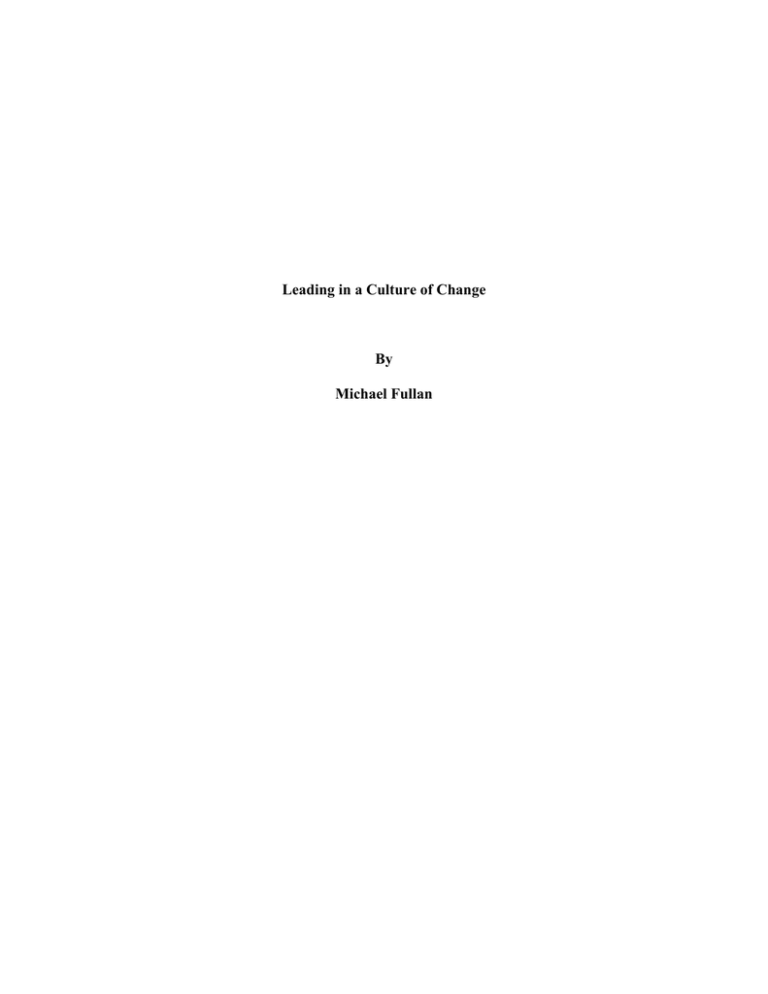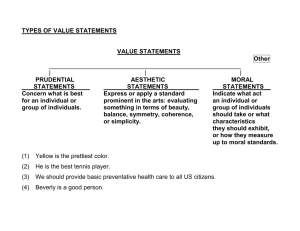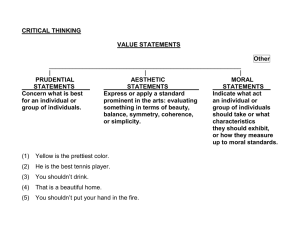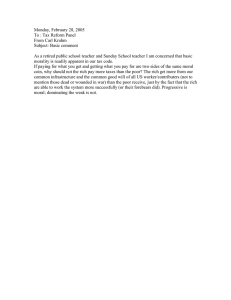Leading in a Culture of Change By Michael Fullan
advertisement

Leading in a Culture of Change By Michael Fullan Contents Preface 1. A Remarkable Convergence 2. Moral Purpose 3. Understanding Change 4. Relationships, Relationships, Relationships 5. Knowledge Building 6. Coherence Making 7. The Hare and the Tortoise Reference About the Author Index 2 Chapter 1 A Remarkable Convergence 3 Chapter Two Moral Purpose Whatever one’s style, every leader, to be effective, must have and work on improving his or her moral purpose. Moral purpose is about both ends and means. Authentic leaders, in other words, display character, and character is the defining characteristic of authentic leadership. Whether people are driven by egoistic (self-centered) or altruistic (unselfish) motives, the fact is that all effective leaders are driven by both. The case of the National Literacy and Numeracy Strategy Moral purpose cannot just; be stated it must be accompanied by strategies for realizing it, and those strategies are the leadership actions that energize people to pursue a desired goal. Leadership, if it is to be effective has to; (1) Have an explicit “making-a-difference” sense of purpose, (2) Use strategies that mobilize many people to tackle though problems, (3) Be held accountable by measured and debatable indicators of success, and (4) Be ultimately assessed by the extent to which it awakens people’s intrinsic commitment, which is none other than the mobilizing of everyone’s sense of moral purpose. The Case of Monsanto A sense of moral purpose on the part of employees is important and can make a huge difference in the performance of the organization, and of the growing significance in the global economy, oral purpose applies outside as well as inside the company. If you want more than short-term gains, moral purpose sincerely sought is good for business. Pluralistic motives can coexist: do good, worry about the environment, and derive a profit. But leaders have to be explicitly aware of the interplay of these three forces. I do not, for a minute think that moral purpose automatically attracts people to do good things. Coherence making, which involves prioritizing and focusing, is greatly facilitated when guided by moral purpose. To achieve moral purpose is to forge interaction—and even mutual purpose—across groups. The message of this chapter is that moral purpose is worthwhile on just about every meaningful criterion; it may not become activated on its own accord, but it is there in nascent form to be cultivated and activated. Although moral purpose is natural, it will flourish only if leaders cultivate it. 4 Chapter Three Understanding Change Remember that a culture of change consists of great rapidity and non-linearity on the one hand and equally great potential for creative breakthroughs on the other. The paradox is that transformation would not be possible without accompanying messiness. The following are the six leadership styles Goleman identified 1. Coercive—the leader demands compliance. (“Do what I tell you.”) 2. Authoritative—the leader mobilizes people toward a vision. (Come with me.”) 3. Affiliative—the leader creates harmony and builds emotional bonds. (“People come first.”) 4. Democratic—the leader forges consensus through participation. (“What do you think?”) 5. Pacesetting—the leader sets high standards for performance. (“Do as I do, now.”) 6. Coaching—the leader develops people for the future. (“Try this.”) Two of the six styles negatively affect climate and, in turn, performance. These were the coercive style (people resent and resist) and the pacesetting style (people get over whelmed and burn out). All four of the other styles had a significant positive impact on climate and performance. The Goal is not to Innovate the Most Relentlessly taking on innovation after innovation is Goleman’s pacesetter leader. In fact, the pacesetting style destroys climate. Many employees feel overwhelmed by the pacesetter’s demands for excellence, and their morale drops—guidelines for working may be clear in the leader’s head, but she does not state them clearly; she expects people to know what to do. Pacesetters must learn the difference between competing in a change marathon and developing the capacity and commitment to solve complex problems. It is not Enough to Have the Best Ideas It is possible to be “dead right.” This is the leader, who has some of the best ideas around but can’t get anyone to buy into them. In fact, the opposite occurs—she experiences overwhelming opposition. The extreme version of this kind of leader is Goleman’s coercive leader. 5 Surely having good ideas is not a bad thing. And yes, it is an element of effective leadership, as in Goleman’s authoritative style. At all times, it helps when leaders have good ideas. But it is easy for authoritative leadership to slip into social engineering when initial excitement cannot be sustained because it cannot be converted to internal commitment. Put another way, the answer is that authoritative leaders need to recognize the weaknesses as well as the strengths in their approach. “Leaders who have mastered four of more—especially the authoritative, democratic, affiliative, and coaching styles—have the best climate and business performance.” Appreciate the Implementation Dip All successful schools experience “implementation dips” as they move forward (Fullan, 2001). The implementation dip is literally a dip in performance and confidence as one encounters an innovation that requires new skills and new understandings. Leaders who understand the implementation dip know that people are experiencing two kinds of problems when they are in the dip—the socialpsychological fear of change, and the lack of technical know how or skills to make the change work. Thus leaders who are sensitive to the implementation dip, combine styles: they still have an urgent sense of moral purpose, they still measure success in terms of results, but they do things that are more likely to get the organization going and keep it going. Redefine Resistance We are more likely to learn something from people who disagree with us than we are from people who agree. Leaders should have good ideas and present them well (the authoritative element) while at the same time seeking and listening to doubters (aspects of democratic leadership). They must try to build good relationships (be affiliative) even with those who may not trust them. We need to represent resisters for two reasons. First, they sometimes have ideas that we might have missed, especially in situations of diversity or complexity or in the tackling of problems for which the answer is unknown. Second, resisters are crucial when it comes to the politics of implementation. In democratic organizations, such as university, being alert to differences of opinion is vital. Successful organizations don’t go with only like-minded innovators; they deliberately build in differences. They don’t mind so much when others—not just themselves—disturb the equilibrium. They also trust the learning process they set 6 up—the focus on moral purpose, the attention to the change process, the building of relationships, the sharing and critical scrutiny of knowledge, and traversing the edge of chaos while seeking coherence. Re-culturing is the Name of the Game We tend to meet any situation by reorganizing. What a wonderful method this can be for creating the illusion of progress: while producing confusion, inefficiency and demoralization. Structure does make a difference, but it is not the main point of achieving success. Transforming the culture—changing the way we do things around here—is the main point. I call this re-culturing. Leading in a culture of change means creating a culture: (not just a structure) of change. It does not mean adopting innovations, one after another; it does mean producing the capacity to seek, critically assess, and selectively incorporate new ideas and practices—all the time, inside the organization as well as outside it. Never a Checklist, Always Complexity It is no doubt clear by now why there can never be a recipe or cookbook for change, nor a step-by-step process. Leaders and members of the organization, because they live in a culture of frenetic change, are vulnerable to seeking the comforting clarity of off-the-shelf solutions. The Complexities of Leadership Complexities can be unlocked and even understood but rarely controlled. The need to have different strategies for different circumstances explains why we cannot generalize from case studies of success. To recommend employing different leadership strategies that simultaneously and sequentially combine different elements seems like complicated advice, but developing this deeper feel for the change process by accumulating insights and wisdom across situations and time may turn out to be the most practical thing we can do—more practical than the best step-by-step models. 7 Chapter Four Relationships, Relationships, Relationships If moral purpose is job one, relationships are job two, as you can’t get anywhere with them. Businesses as if They Had Souls In a nonlinear, dynamic world, everything exists only in relationship to everything else, and the interactions among agents in the system lead to complex, unpredictable outcomes. In this world, interactions, or relationships, among its agents are the organizing principle. The “soul at work” is both individual and collective: “Actually, most people want to be part of their organization; they want to know the organization’s purpose; they want to make a difference. When the individual soul is connected to the organization, people become connected to something deeper—the desire to contribute to a larger purpose, to feel they are part of a greater whole, a web of connection. Essentials to developing relationships (1) setting clear standards, (2) expecting the best, (3) paying attention, (4) personalizing recognition, (5) telling the story, (6) celebrating together, and (7) setting the example. Schools as if They Had Minds Development of individuals is not sufficient. New relationships (as found in a professional learning community) are crucial, but only if they work at the hard task of establishing greater program coherence and the addition of resources. The role of leadership (in this case, the principal) is to “cause” greater capacity in the organization in order to get better results. Collaborative cultures, which by definition have close relationships, are indeed powerful, but unless they are focusing on the right things they may end up being powerfully wrong. Moral purpose, good ideas, focusing on results, and obtaining the views of dissenters are essential, because they mean that the organization is focusing on the right things. Emotional Intelligence and Resistance The culture of change I have been describing is, by definition, rife with anxiety, stress, and ambiguity (and correspondingly with the exhilaration of creative breakthroughs). It should come as no surprise then that the most effective leaders are not the smartest in an IQ sense but are those who combine intellectual brilliance with emotional intelligence. 8 Five main emotional competency sets: Self-awareness (knowing one’s internal state, preferences, resources, and intuitions) Self-regulation (managing one’s internal states, impulses, and resources) Motivation (emotional tendencies that guide or facilitate reaching goals) Empathy (awareness of others’ feelings, needs, and concerns) Social skills (adeptness at inducing desirable responses from others) Defining effective leadership as appreciating resistance is another one of those remarkable discoveries: dissent is seen as a potential source of new ideas and breakthroughs. 9 Chapter Five Knowledge Building If you remember one thing about information, it is that it only becomes valuable in a social context. Attending too closely to information overlooks the social context that helps people understand what that information might mean and why it matters. Most organizations have invested heavily in technology and possibly training, but hardly at all in knowledge sharing and creation. And when they do attempt to share and use new knowledge, they find it enormously difficult. Examples from Business Crucial distinction between explicit knowledge (words and numbers that can be communicated in the form of data and information) and tacit knowledge (skills, beliefs, and understanding that are below the level of awareness). The sharing of tacit knowledge among multiple individuals with different backgrounds, perspectives, and motivations becomes the critical step for organizational knowledge creation to take place. Good relationships purge a knowledge-creation process of distrust, fear, and dissatisfaction, and allow organizational members to feel safe enough to explore the unknown territories of new markets, new customers, new products, and new manufacturing technologies. Establishing knowledge sharing practices is as much a route to creating collaborative culture as the organization must frame the giving and receiving of knowledge as a responsibility and must reinforce such sharing through incentives and opportunities to engage in it. The logic of what we are talking about should be clear: (1) Complex, turbulent environments constantly generate messiness and reams of ideas; (2) Interacting individuals are the key to accessing and sorting out these ideas; (3) Individuals will not engage in sharing unless they find it motivating to do so (whether because they feel valued and are valued, because they are getting something in return, or because they want to contribute to a bigger vision). It is important to note that companies must name knowledge sharing as a core value and then establish mechanisms and procedures that embody the value in action. “Army After Action Reviews” have standardized three key questions: What was supposed to happen? What happened? And what accounts for the difference? An AAR may last fifteen minutes or an hour depending on the action that is being discussed, but in any case, it is not a lengthy meeting. 10 Examples from Education It is one of life’s great ironies: schools are in the business of teaching and learning, yet they are terrible at learning from each other. If they ever discover how to do this, their future is assured. Inter-visitation and Peer Networks You would think that schools in total know a lot about teaching reading, writing and mathematics—and you would be right. You would also think that accessing this information would be a top priority—and you would be wrong. What is going on here? Well, over the years, schools have built up all kinds of structural and cultural barriers to sharing, and they are having a devil of a time overcoming this inertia. (If they weren’t so well protected by having nearly a monopoly, and if they weren’t so essential to the future of democracy, they would be long gone.) Yet we are finding that teachers and principles, once they experience knowledge sharing, are thirsting for more. They literally can’t get enough of it. 11 Chapter Six Coherence Making Change is a leader’s friend, but it has a split personality: its nonlinear messiness gets us into trouble. Four principles of a “living system” 1. Equilibrium is a precursor to death. When a living system is in a state of equilibrium, it is less responsive to change occurring around it. This places it at maximum risk. 2. In the face of threat, or when galvanized by a compelling opportunity, living things move toward the edge of chaos. This condition evokes higher levels of mutation and experimentation, and fresh new solutions are more likely to be found. 3. When this excitation takes place, the components of living systems selforganize and new forms and repertoires emerge from the turmoil. 4. Living systems cannot be directed along a linear path. Unforeseen consequences are inevitable. The challenge is to disturb them in a manner that approximates the desired outcome. The Disturbance Part In schools, for example, the main problem is not the absence of innovations but the presence of too many disconnected, episodic, piecemeal, superficially adorned projects. Rather than contributing to substantial improvements, adopting improvement programs may also add to the endless cycle of initiatives that seem to sap the strength and spirit of schools and their communities. The situation Hatch describes is not what I mean by disturbance. Productive disturbance is likely to happen when it is guided by moral purpose and when the process creates and channels new tensions while working on a complex problem. Change your approach to strategy and you change the way a company runs. The leader becomes a context setter, the designer of a learning experience—not an authority figure with solutions. Once the folks at the grassroots realize they own the problem, they also discover that they can help create and own the answer—and they get after it very quickly; very aggressively, and very creatively, with a lot more ideas than the old-style strategic direction could ever have prescribed from headquarters. When change occurs, there will be disturbances, and this means that there will be differences of opinion that must be reconciled. Effective leadership means guiding people through the differences and, indeed, enabling differences to surface. 12 The Coherence-Making Part Self-organizing concerns new patterns of relationship and action that emerge when you set up the conditions and processes. When you do this the dynamics are such that the organization shifts to a new state as a result of the new interactions and ideas. Such new states represent breakthroughs in which greater coherence is achieved. Strange attractors involve experiences or forces that attract the energies and commitment of employees. They are strange because they are not predictable in a specific sense, but as outcomes are likely (if not inevitable) in the processes, we are describing. In other words, the most powerful coherence is a function of having worked through the ambiguities and complexities of hard-to-solve problems. This moral purpose-outcome combination won’t work if we don’t respect the messiness of the process required to identify best solutions and generate internal commitment from the majority of organization members. 13 Chapter Seven The Hare and the Tortoise Slow Knowing Recent scientific evidence shows convincingly that the more patient, less deliberate modes are particularly suited to making sense of situations that are intricate, shadowy or ill defined. Remaining attentive is to have moral purpose; incomprehension is to respect the complexities of situations that do not have easy answers. Beware of leaders who are always sure of themselves. Effective leaders listen attentively—you can almost hear them listening. Ineffective leaders make up their minds prematurely and by definition, listen less thereafter. Paradoxically, slow knowing doesn’t have to take a long time. It is more of a disposition that can be “acquired and practiced.” Effective leaders don’t panic when things go wrong in the early stages of a major change initiative. It is not so much that they take their time, but rather that they know it takes time for things to gel. Learning in Context This is a fantastic insight: learning in the setting where you work, or learning in context, is the learning with the greatest payoff because it is more specific (customized to the situation) and because it is social (involves the group). Learning in context is developing leadership and improving the organization as you go. Such learning changes the individual and the context simultaneously. Leadership must create conditions that value learning as both an individual and collective good. Privacy of practice produces isolation; isolation is the enemy of improvement. Organizations transform when they can establish mechanisms for learning in the dailiness of organizational life. People make… fundamental transitions by having many opportunities to be exposed to ideas, to argue them to their own normative belief systems, to practice the behaviors that go with those values, to observe others practicing those behaviors and most importantly to be successful at practicing in the presence of others (that is, to be seen to be successful) Mentors who evidence moral purpose, display emotional intelligence, and foster caring relationships and norms of reciprocity for knowledge sharing, show the way. The obligation is to remove barriers to sharing, create mechanisms for sharing, and reward those who do share. 14 Leadership for Many Strong institutions have many leaders at all level’s. Thus, the ultimate leadership contribution is to develop leaders in the organization who can move the organization even further after you have left. A Time to Disturb As we are careening into the future is the very time we need leadership the most. Yet leadership in all institutions is in short supply and worsening. Leadership appropriate for the times is a scarce commodity. Pervasive leadership has a greater likelihood of occurring if leaders work on mastering the five core capacities: moral purpose, understanding of the change process, building relationships, knowledge building and coherence making. 15




